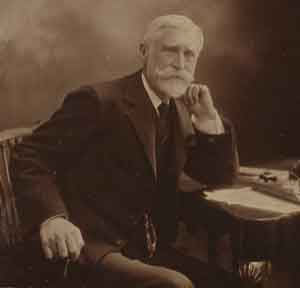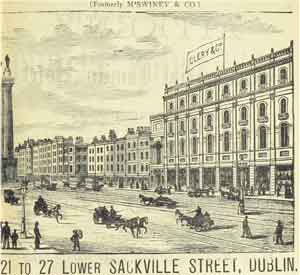CLERY’S: THE ARCHIVES
Published in Issue 2 (March/April 2023), Reviews, Volume 31By Donal Fallon
This year marks the twentieth anniversary of the unveiling of Ian Ritchie’s Spire in O’Connell Street, a modern addition to the main thoroughfare which Ritchie said was ‘inspired by the ever-changing light and composition of the Irish skies’. Just over a thousand curious Dubliners gathered in the street below to watch the installation of the final piece of the work, which replaced Francis Johnston’s column to Horatio Nelson, toppled some 37 years before by Liam Sutcliffe’s explosive device.
In 2003 there was much talk in the press about the regeneration of O’Connell Street, with the then city manager, John Fitzgerald, stating that ‘it takes a long, long time to resurrect a street, and we’ve learned that the hard way … but we will see it through’. Two decades on, the jury is still out, not helped by a pandemic which removed some smaller businesses from the street. Just as the Spire promised a rebirth, many have put their faith in a new Clery’s to bring fresh life to O’Connell Street.
Clery’s had withstood much. The chaos of the 1913 Lockout saw one of its most recognisable directors, William Martin Murphy, entangled in the greatest labour dispute in the history of the capital. The Easter Rising brought both looters and an inferno, something captured in the recollections of Oscar Traynor, who recounted how ‘I had the extraordinary experience of seeing the huge plate-glass windows of Clery’s stores run molten into the channel from the terrific heat’. The Economic War with Britain, the global Great Depression and the Emergency almost put the store out of business in the 1930s and ’40s, but still nothing seemed capable of permanently closing the doors of the department store. Then, on a Friday evening in June 2015, the unimaginable happened. More than 4,000 Clery’s workers were told that their jobs were gone, with immediate effect, while locks were changed before their eyes. The liquidation announcement occurred at the bottom of the famous staircase of the department store—about the only surviving feature of its new deluxe interior.
By January 2023, and with the reopening of Clery’s as a retail destination imminent, ‘Clery’s: The Archives’ is an exhibition seeking to contextualise the store within the story of its surroundings and the city. At first glance inside a distinctly different physical premises, the exhibition draws from primary source documentary material to tell the story of Clery’s from its inception in the mid-nineteenth century. A first exhibition from curator and public historian Caitlin White, telling the story of Clery’s was no easy task, as many of the remnants of Clery’s original museum were sold at auction following the liquidation of the business in 2015. Here some familiar items are brought back to the store, along with a rich archival dig of images and quotations, and good use of audio-visual material.
Positioned in the lobby of the new premises, the surroundings are both familiar and unrecognisable. Henry J. Lyons, the architectural firm tasked with the Clery’s redevelopment, insisted that ‘the sympathetic transformation of the listed Clery’s Building will include the restoration of iconic features, including the colonnaded façade, internal staircases, columns and ceilings and the famous Clery’s’ clock’. It is the newness of the space, however, that is most physically striking. Through the lobby, historic artefacts are presented in display cases, while White has written a potted history of the premises, presented on boards on each side. It includes much that was new to this visitor—how many know that Clery’s went bankrupt in 1940, for example, to be rescued by Denis Guiney? Proprietor of the nearby business that carried his name on Talbot Street since May 1921, Guiney was described in the press as ‘a great advocate of the development of Irish industry, and a keen believer in the value of advertising’.
Reflecting the curator’s own research interests (White is also a guide with the 1916 Rebellion Walking Tour), the Easter Rising and its impacts on Clery’s—both physical and financial—are well examined. One of the choice quotations produced in large text comes from Ernie O’Malley’s On another man’s wound, one of the most colourful depictions of looters on Easter Monday. O’Malley remembered that ‘ragged boys wearing old boots, brown and black, tramped up and down with air rifles on their shoulders or played cowboys and Indians, armed with black pistols supplied with long rows of paper caps. Little girls hugged teddy bears and dolls as if they could hardly believe their good fortune.’ Ledgers from the immediate aftermath of the Rising show how Clery’s battled financially to keep the company afloat.
It would be some six years after the Easter Rising before the reopening of Clery’s, which we learn was modelled on London’s Selfridges—an event which, like today, was heralded as a moment of rebirth for the street. On display is an ornate ceremonial gold key, used for the reopening of the store in August 1922.

Above: William Martin Murphy, one of Clery’s most recognisable directors, was entangled in the greatest labour dispute in the history of the capital in 1913.
Where the exhibition works best is when it draws on oral testimony—the story of Clery’s is ultimately the story not only of its workers but also of its customers. Colm Nicell and Garry Walsh’s documentary film explores the Dublin tradition of Clery’s clock as a meeting place for courting couples. The clock that we know today is a surprisingly modern addition to the building, added only in 1990, though there has been a clock on the exterior of the shop for a century now. At the unveiling of the current clock in 1990, readers of one newspaper were told that it ‘is rivalled only as a meeting place by the gates of Trinity College, ever since the demise of Nelson’s Pillar’.
The Pillar brings us back nicely to the start. In 1966 Dublin wits sang ‘I can see Clery’s now the Pillar’s gone’, which was reprised in 2003 as ‘I can see Clery’s now the crane has gone’, but there has been little to laugh about in the story of the main street of the capital in recent decades. Much is riding on a rejuvenated and reimagined Clery’s.
Donal Fallon is the host of the Three Castles Burning podcast and the author of Three castles burning: a history of Dublin in twelve streets (New Island, 2022).


















